Professional Accountability And Patient Safety
VerifiedAdded on 2023/04/11
|10
|2466
|431
AI Summary
This essay analyzes a case of professional misconduct in the medical field, focusing on the role of the nursing practitioner and the outcomes on the patient. It discusses the importance of professionalism and patient safety in healthcare.
Contribute Materials
Your contribution can guide someone’s learning journey. Share your
documents today.
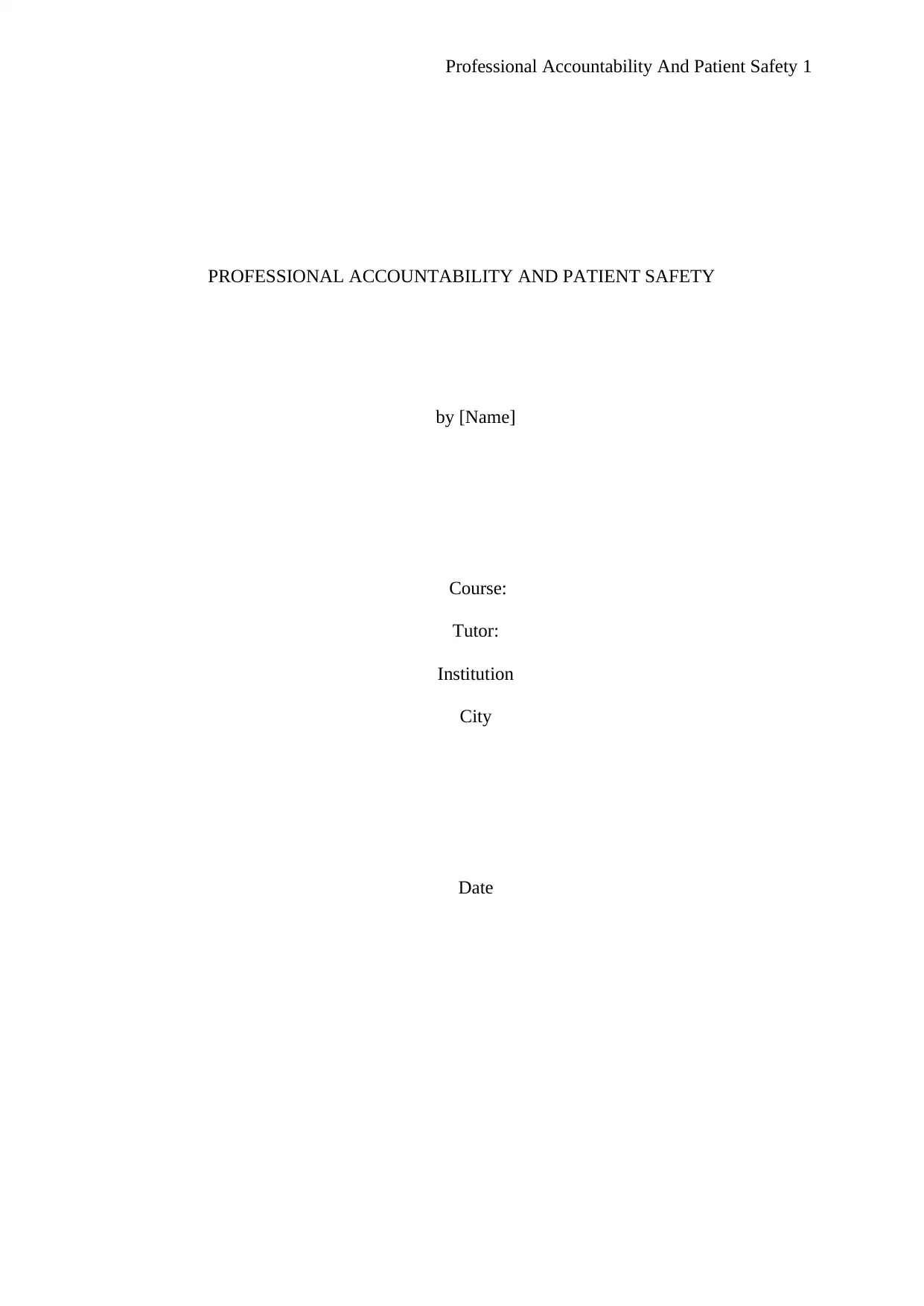
Professional Accountability And Patient Safety 1
PROFESSIONAL ACCOUNTABILITY AND PATIENT SAFETY
by [Name]
Course:
Tutor:
Institution
City
Date
PROFESSIONAL ACCOUNTABILITY AND PATIENT SAFETY
by [Name]
Course:
Tutor:
Institution
City
Date
Secure Best Marks with AI Grader
Need help grading? Try our AI Grader for instant feedback on your assignments.
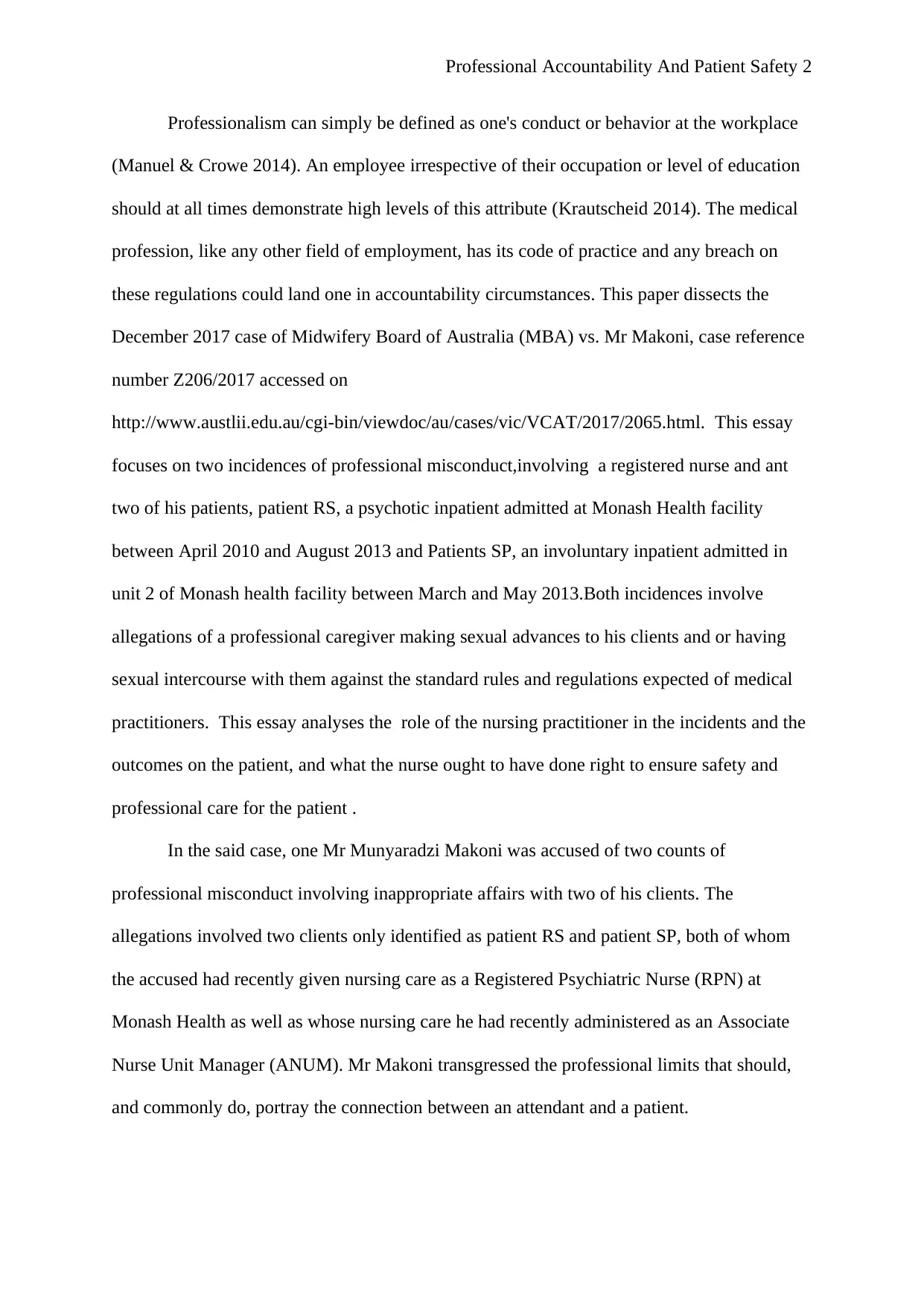
Professional Accountability And Patient Safety 2
Professionalism can simply be defined as one's conduct or behavior at the workplace
(Manuel & Crowe 2014). An employee irrespective of their occupation or level of education
should at all times demonstrate high levels of this attribute (Krautscheid 2014). The medical
profession, like any other field of employment, has its code of practice and any breach on
these regulations could land one in accountability circumstances. This paper dissects the
December 2017 case of Midwifery Board of Australia (MBA) vs. Mr Makoni, case reference
number Z206/2017 accessed on
http://www.austlii.edu.au/cgi-bin/viewdoc/au/cases/vic/VCAT/2017/2065.html. This essay
focuses on two incidences of professional misconduct,involving a registered nurse and ant
two of his patients, patient RS, a psychotic inpatient admitted at Monash Health facility
between April 2010 and August 2013 and Patients SP, an involuntary inpatient admitted in
unit 2 of Monash health facility between March and May 2013.Both incidences involve
allegations of a professional caregiver making sexual advances to his clients and or having
sexual intercourse with them against the standard rules and regulations expected of medical
practitioners. This essay analyses the role of the nursing practitioner in the incidents and the
outcomes on the patient, and what the nurse ought to have done right to ensure safety and
professional care for the patient .
In the said case, one Mr Munyaradzi Makoni was accused of two counts of
professional misconduct involving inappropriate affairs with two of his clients. The
allegations involved two clients only identified as patient RS and patient SP, both of whom
the accused had recently given nursing care as a Registered Psychiatric Nurse (RPN) at
Monash Health as well as whose nursing care he had recently administered as an Associate
Nurse Unit Manager (ANUM). Mr Makoni transgressed the professional limits that should,
and commonly do, portray the connection between an attendant and a patient.
Professionalism can simply be defined as one's conduct or behavior at the workplace
(Manuel & Crowe 2014). An employee irrespective of their occupation or level of education
should at all times demonstrate high levels of this attribute (Krautscheid 2014). The medical
profession, like any other field of employment, has its code of practice and any breach on
these regulations could land one in accountability circumstances. This paper dissects the
December 2017 case of Midwifery Board of Australia (MBA) vs. Mr Makoni, case reference
number Z206/2017 accessed on
http://www.austlii.edu.au/cgi-bin/viewdoc/au/cases/vic/VCAT/2017/2065.html. This essay
focuses on two incidences of professional misconduct,involving a registered nurse and ant
two of his patients, patient RS, a psychotic inpatient admitted at Monash Health facility
between April 2010 and August 2013 and Patients SP, an involuntary inpatient admitted in
unit 2 of Monash health facility between March and May 2013.Both incidences involve
allegations of a professional caregiver making sexual advances to his clients and or having
sexual intercourse with them against the standard rules and regulations expected of medical
practitioners. This essay analyses the role of the nursing practitioner in the incidents and the
outcomes on the patient, and what the nurse ought to have done right to ensure safety and
professional care for the patient .
In the said case, one Mr Munyaradzi Makoni was accused of two counts of
professional misconduct involving inappropriate affairs with two of his clients. The
allegations involved two clients only identified as patient RS and patient SP, both of whom
the accused had recently given nursing care as a Registered Psychiatric Nurse (RPN) at
Monash Health as well as whose nursing care he had recently administered as an Associate
Nurse Unit Manager (ANUM). Mr Makoni transgressed the professional limits that should,
and commonly do, portray the connection between an attendant and a patient.
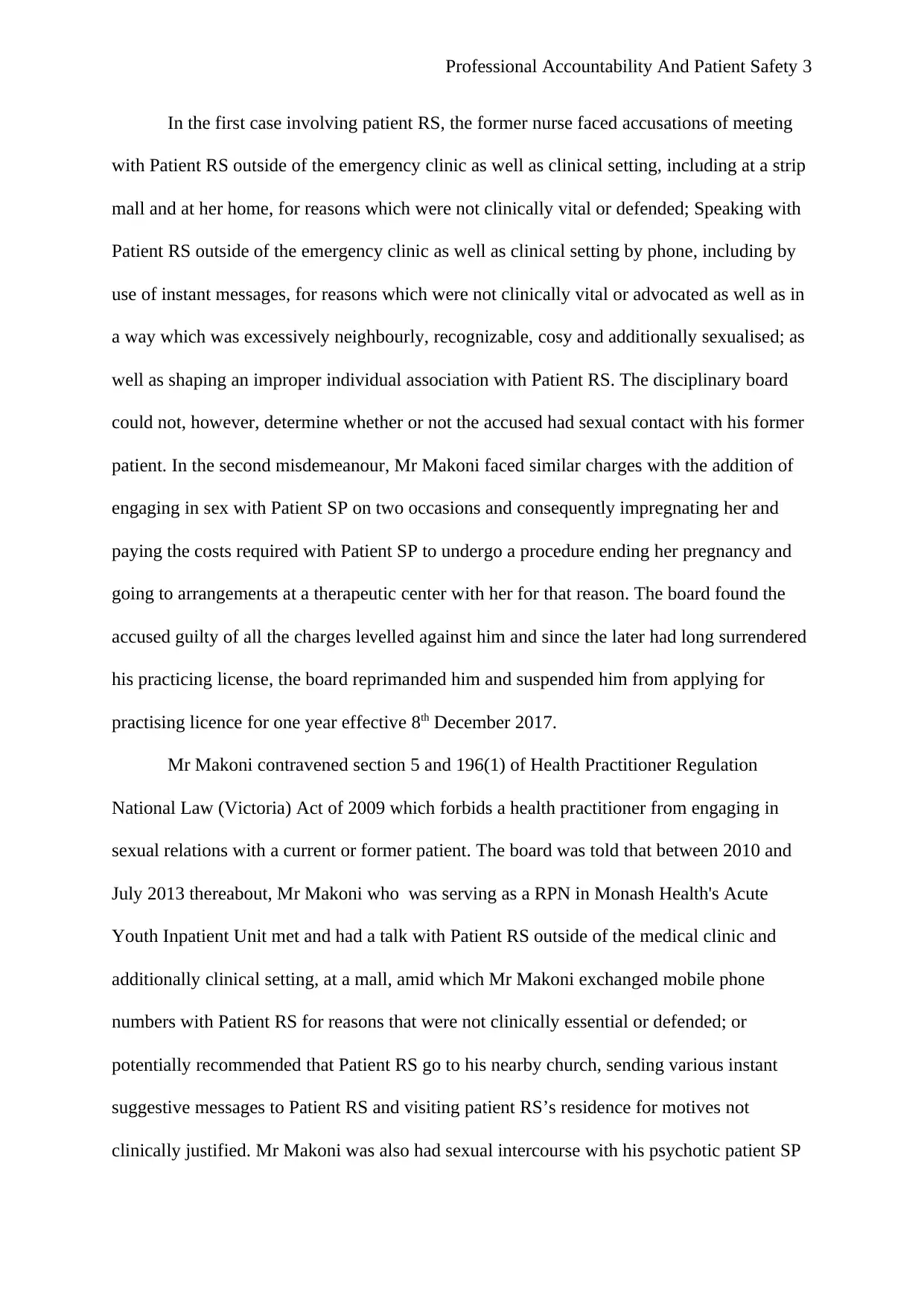
Professional Accountability And Patient Safety 3
In the first case involving patient RS, the former nurse faced accusations of meeting
with Patient RS outside of the emergency clinic as well as clinical setting, including at a strip
mall and at her home, for reasons which were not clinically vital or defended; Speaking with
Patient RS outside of the emergency clinic as well as clinical setting by phone, including by
use of instant messages, for reasons which were not clinically vital or advocated as well as in
a way which was excessively neighbourly, recognizable, cosy and additionally sexualised; as
well as shaping an improper individual association with Patient RS. The disciplinary board
could not, however, determine whether or not the accused had sexual contact with his former
patient. In the second misdemeanour, Mr Makoni faced similar charges with the addition of
engaging in sex with Patient SP on two occasions and consequently impregnating her and
paying the costs required with Patient SP to undergo a procedure ending her pregnancy and
going to arrangements at a therapeutic center with her for that reason. The board found the
accused guilty of all the charges levelled against him and since the later had long surrendered
his practicing license, the board reprimanded him and suspended him from applying for
practising licence for one year effective 8th December 2017.
Mr Makoni contravened section 5 and 196(1) of Health Practitioner Regulation
National Law (Victoria) Act of 2009 which forbids a health practitioner from engaging in
sexual relations with a current or former patient. The board was told that between 2010 and
July 2013 thereabout, Mr Makoni who was serving as a RPN in Monash Health's Acute
Youth Inpatient Unit met and had a talk with Patient RS outside of the medical clinic and
additionally clinical setting, at a mall, amid which Mr Makoni exchanged mobile phone
numbers with Patient RS for reasons that were not clinically essential or defended; or
potentially recommended that Patient RS go to his nearby church, sending various instant
suggestive messages to Patient RS and visiting patient RS’s residence for motives not
clinically justified. Mr Makoni was also had sexual intercourse with his psychotic patient SP
In the first case involving patient RS, the former nurse faced accusations of meeting
with Patient RS outside of the emergency clinic as well as clinical setting, including at a strip
mall and at her home, for reasons which were not clinically vital or defended; Speaking with
Patient RS outside of the emergency clinic as well as clinical setting by phone, including by
use of instant messages, for reasons which were not clinically vital or advocated as well as in
a way which was excessively neighbourly, recognizable, cosy and additionally sexualised; as
well as shaping an improper individual association with Patient RS. The disciplinary board
could not, however, determine whether or not the accused had sexual contact with his former
patient. In the second misdemeanour, Mr Makoni faced similar charges with the addition of
engaging in sex with Patient SP on two occasions and consequently impregnating her and
paying the costs required with Patient SP to undergo a procedure ending her pregnancy and
going to arrangements at a therapeutic center with her for that reason. The board found the
accused guilty of all the charges levelled against him and since the later had long surrendered
his practicing license, the board reprimanded him and suspended him from applying for
practising licence for one year effective 8th December 2017.
Mr Makoni contravened section 5 and 196(1) of Health Practitioner Regulation
National Law (Victoria) Act of 2009 which forbids a health practitioner from engaging in
sexual relations with a current or former patient. The board was told that between 2010 and
July 2013 thereabout, Mr Makoni who was serving as a RPN in Monash Health's Acute
Youth Inpatient Unit met and had a talk with Patient RS outside of the medical clinic and
additionally clinical setting, at a mall, amid which Mr Makoni exchanged mobile phone
numbers with Patient RS for reasons that were not clinically essential or defended; or
potentially recommended that Patient RS go to his nearby church, sending various instant
suggestive messages to Patient RS and visiting patient RS’s residence for motives not
clinically justified. Mr Makoni was also had sexual intercourse with his psychotic patient SP
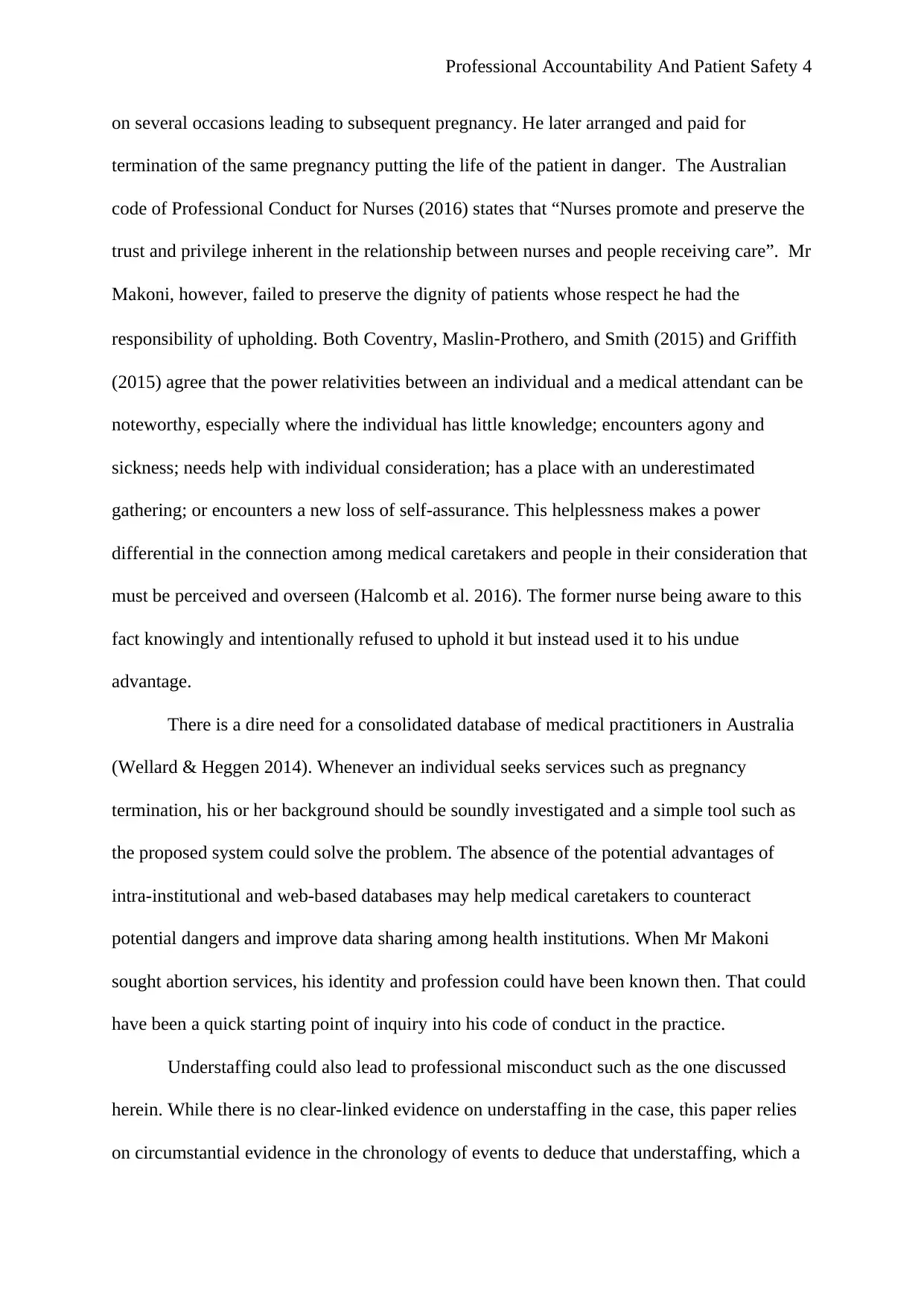
Professional Accountability And Patient Safety 4
on several occasions leading to subsequent pregnancy. He later arranged and paid for
termination of the same pregnancy putting the life of the patient in danger. The Australian
code of Professional Conduct for Nurses (2016) states that “Nurses promote and preserve the
trust and privilege inherent in the relationship between nurses and people receiving care”. Mr
Makoni, however, failed to preserve the dignity of patients whose respect he had the
responsibility of upholding. Both Coventry, Maslin‐Prothero, and Smith (2015) and Griffith
(2015) agree that the power relativities between an individual and a medical attendant can be
noteworthy, especially where the individual has little knowledge; encounters agony and
sickness; needs help with individual consideration; has a place with an underestimated
gathering; or encounters a new loss of self-assurance. This helplessness makes a power
differential in the connection among medical caretakers and people in their consideration that
must be perceived and overseen (Halcomb et al. 2016). The former nurse being aware to this
fact knowingly and intentionally refused to uphold it but instead used it to his undue
advantage.
There is a dire need for a consolidated database of medical practitioners in Australia
(Wellard & Heggen 2014). Whenever an individual seeks services such as pregnancy
termination, his or her background should be soundly investigated and a simple tool such as
the proposed system could solve the problem. The absence of the potential advantages of
intra-institutional and web-based databases may help medical caretakers to counteract
potential dangers and improve data sharing among health institutions. When Mr Makoni
sought abortion services, his identity and profession could have been known then. That could
have been a quick starting point of inquiry into his code of conduct in the practice.
Understaffing could also lead to professional misconduct such as the one discussed
herein. While there is no clear-linked evidence on understaffing in the case, this paper relies
on circumstantial evidence in the chronology of events to deduce that understaffing, which a
on several occasions leading to subsequent pregnancy. He later arranged and paid for
termination of the same pregnancy putting the life of the patient in danger. The Australian
code of Professional Conduct for Nurses (2016) states that “Nurses promote and preserve the
trust and privilege inherent in the relationship between nurses and people receiving care”. Mr
Makoni, however, failed to preserve the dignity of patients whose respect he had the
responsibility of upholding. Both Coventry, Maslin‐Prothero, and Smith (2015) and Griffith
(2015) agree that the power relativities between an individual and a medical attendant can be
noteworthy, especially where the individual has little knowledge; encounters agony and
sickness; needs help with individual consideration; has a place with an underestimated
gathering; or encounters a new loss of self-assurance. This helplessness makes a power
differential in the connection among medical caretakers and people in their consideration that
must be perceived and overseen (Halcomb et al. 2016). The former nurse being aware to this
fact knowingly and intentionally refused to uphold it but instead used it to his undue
advantage.
There is a dire need for a consolidated database of medical practitioners in Australia
(Wellard & Heggen 2014). Whenever an individual seeks services such as pregnancy
termination, his or her background should be soundly investigated and a simple tool such as
the proposed system could solve the problem. The absence of the potential advantages of
intra-institutional and web-based databases may help medical caretakers to counteract
potential dangers and improve data sharing among health institutions. When Mr Makoni
sought abortion services, his identity and profession could have been known then. That could
have been a quick starting point of inquiry into his code of conduct in the practice.
Understaffing could also lead to professional misconduct such as the one discussed
herein. While there is no clear-linked evidence on understaffing in the case, this paper relies
on circumstantial evidence in the chronology of events to deduce that understaffing, which a
Secure Best Marks with AI Grader
Need help grading? Try our AI Grader for instant feedback on your assignments.
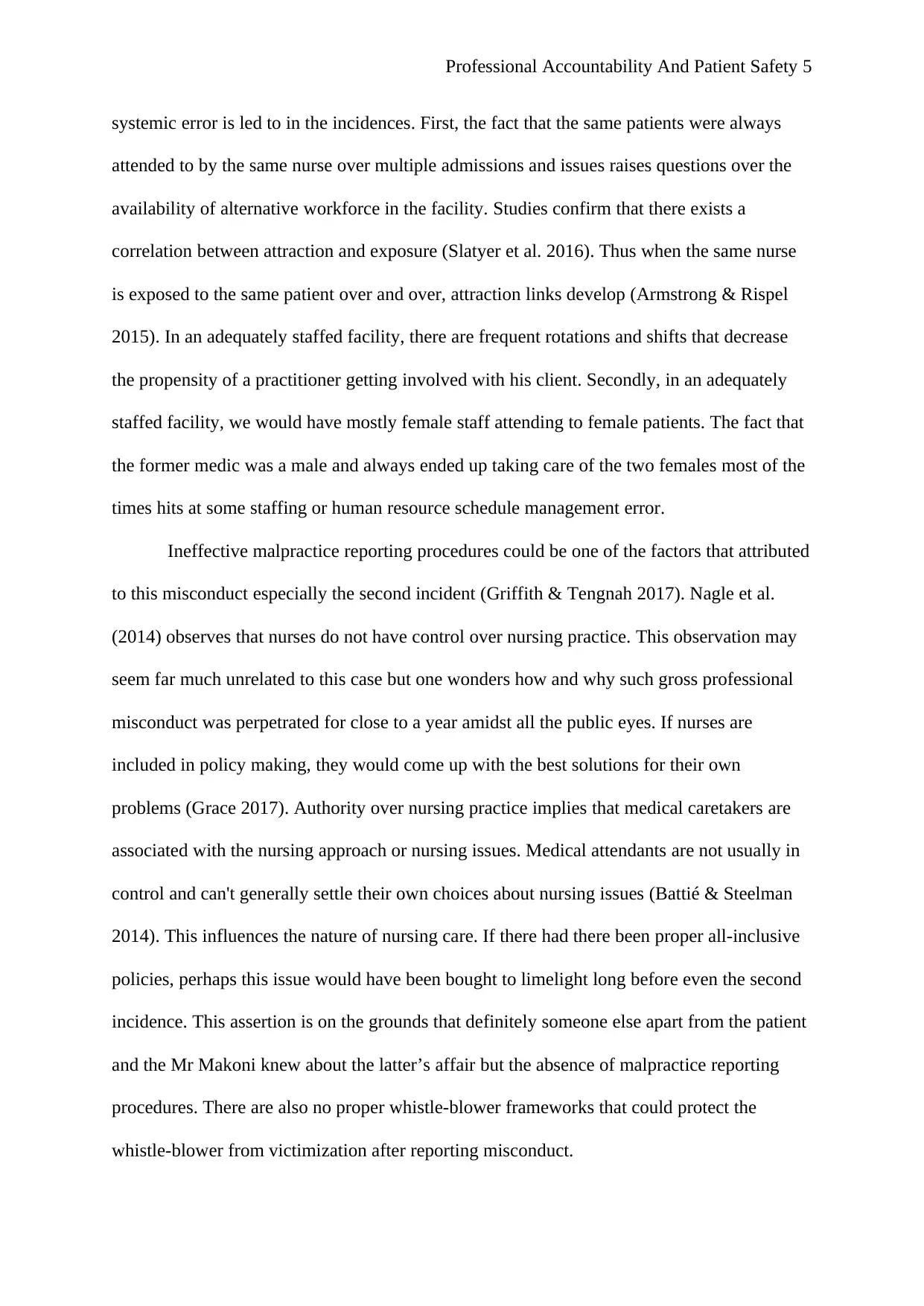
Professional Accountability And Patient Safety 5
systemic error is led to in the incidences. First, the fact that the same patients were always
attended to by the same nurse over multiple admissions and issues raises questions over the
availability of alternative workforce in the facility. Studies confirm that there exists a
correlation between attraction and exposure (Slatyer et al. 2016). Thus when the same nurse
is exposed to the same patient over and over, attraction links develop (Armstrong & Rispel
2015). In an adequately staffed facility, there are frequent rotations and shifts that decrease
the propensity of a practitioner getting involved with his client. Secondly, in an adequately
staffed facility, we would have mostly female staff attending to female patients. The fact that
the former medic was a male and always ended up taking care of the two females most of the
times hits at some staffing or human resource schedule management error.
Ineffective malpractice reporting procedures could be one of the factors that attributed
to this misconduct especially the second incident (Griffith & Tengnah 2017). Nagle et al.
(2014) observes that nurses do not have control over nursing practice. This observation may
seem far much unrelated to this case but one wonders how and why such gross professional
misconduct was perpetrated for close to a year amidst all the public eyes. If nurses are
included in policy making, they would come up with the best solutions for their own
problems (Grace 2017). Authority over nursing practice implies that medical caretakers are
associated with the nursing approach or nursing issues. Medical attendants are not usually in
control and can't generally settle their own choices about nursing issues (Battié & Steelman
2014). This influences the nature of nursing care. If there had there been proper all-inclusive
policies, perhaps this issue would have been bought to limelight long before even the second
incidence. This assertion is on the grounds that definitely someone else apart from the patient
and the Mr Makoni knew about the latter’s affair but the absence of malpractice reporting
procedures. There are also no proper whistle-blower frameworks that could protect the
whistle-blower from victimization after reporting misconduct.
systemic error is led to in the incidences. First, the fact that the same patients were always
attended to by the same nurse over multiple admissions and issues raises questions over the
availability of alternative workforce in the facility. Studies confirm that there exists a
correlation between attraction and exposure (Slatyer et al. 2016). Thus when the same nurse
is exposed to the same patient over and over, attraction links develop (Armstrong & Rispel
2015). In an adequately staffed facility, there are frequent rotations and shifts that decrease
the propensity of a practitioner getting involved with his client. Secondly, in an adequately
staffed facility, we would have mostly female staff attending to female patients. The fact that
the former medic was a male and always ended up taking care of the two females most of the
times hits at some staffing or human resource schedule management error.
Ineffective malpractice reporting procedures could be one of the factors that attributed
to this misconduct especially the second incident (Griffith & Tengnah 2017). Nagle et al.
(2014) observes that nurses do not have control over nursing practice. This observation may
seem far much unrelated to this case but one wonders how and why such gross professional
misconduct was perpetrated for close to a year amidst all the public eyes. If nurses are
included in policy making, they would come up with the best solutions for their own
problems (Grace 2017). Authority over nursing practice implies that medical caretakers are
associated with the nursing approach or nursing issues. Medical attendants are not usually in
control and can't generally settle their own choices about nursing issues (Battié & Steelman
2014). This influences the nature of nursing care. If there had there been proper all-inclusive
policies, perhaps this issue would have been bought to limelight long before even the second
incidence. This assertion is on the grounds that definitely someone else apart from the patient
and the Mr Makoni knew about the latter’s affair but the absence of malpractice reporting
procedures. There are also no proper whistle-blower frameworks that could protect the
whistle-blower from victimization after reporting misconduct.
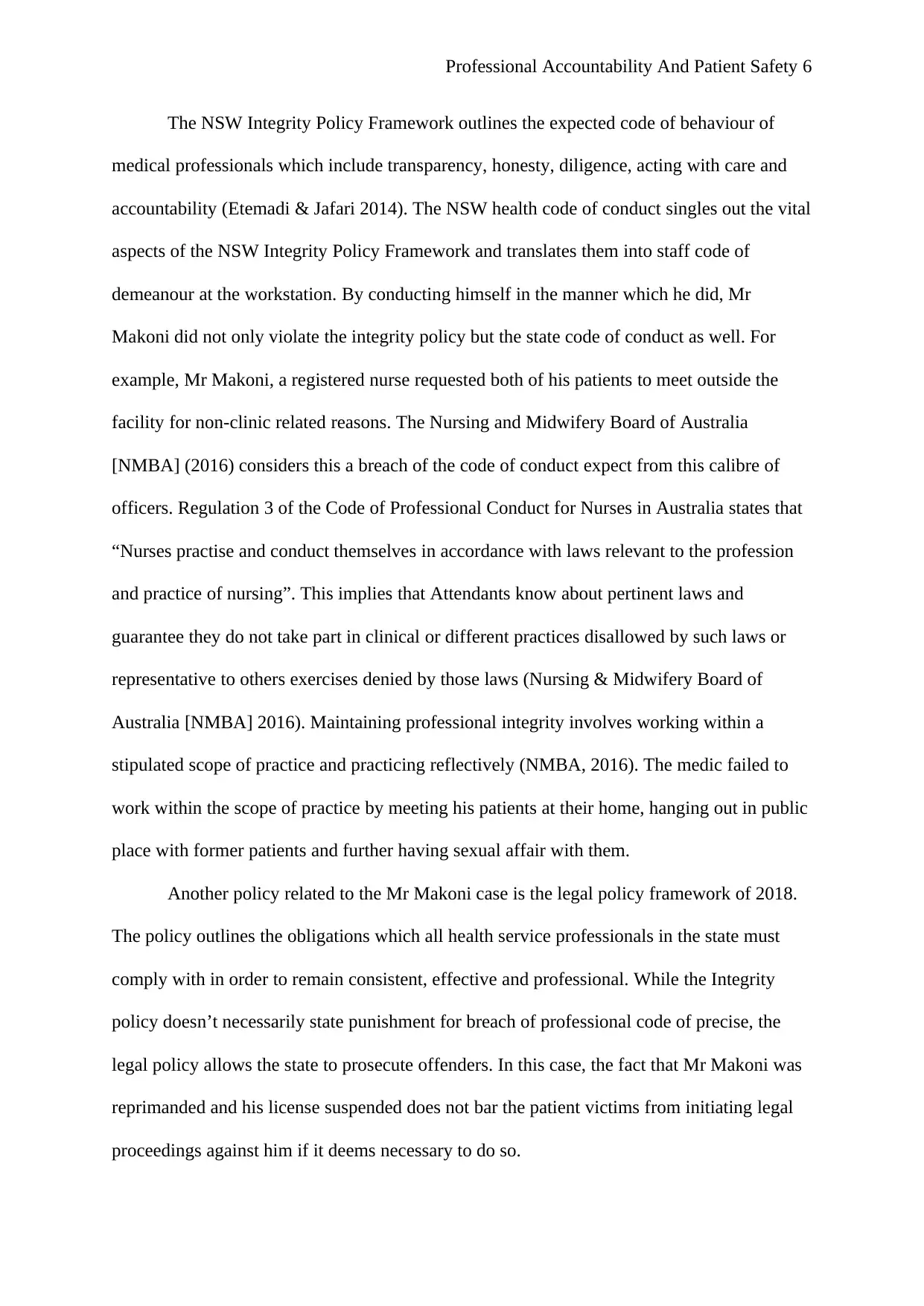
Professional Accountability And Patient Safety 6
The NSW Integrity Policy Framework outlines the expected code of behaviour of
medical professionals which include transparency, honesty, diligence, acting with care and
accountability (Etemadi & Jafari 2014). The NSW health code of conduct singles out the vital
aspects of the NSW Integrity Policy Framework and translates them into staff code of
demeanour at the workstation. By conducting himself in the manner which he did, Mr
Makoni did not only violate the integrity policy but the state code of conduct as well. For
example, Mr Makoni, a registered nurse requested both of his patients to meet outside the
facility for non-clinic related reasons. The Nursing and Midwifery Board of Australia
[NMBA] (2016) considers this a breach of the code of conduct expect from this calibre of
officers. Regulation 3 of the Code of Professional Conduct for Nurses in Australia states that
“Nurses practise and conduct themselves in accordance with laws relevant to the profession
and practice of nursing”. This implies that Attendants know about pertinent laws and
guarantee they do not take part in clinical or different practices disallowed by such laws or
representative to others exercises denied by those laws (Nursing & Midwifery Board of
Australia [NMBA] 2016). Maintaining professional integrity involves working within a
stipulated scope of practice and practicing reflectively (NMBA, 2016). The medic failed to
work within the scope of practice by meeting his patients at their home, hanging out in public
place with former patients and further having sexual affair with them.
Another policy related to the Mr Makoni case is the legal policy framework of 2018.
The policy outlines the obligations which all health service professionals in the state must
comply with in order to remain consistent, effective and professional. While the Integrity
policy doesn’t necessarily state punishment for breach of professional code of precise, the
legal policy allows the state to prosecute offenders. In this case, the fact that Mr Makoni was
reprimanded and his license suspended does not bar the patient victims from initiating legal
proceedings against him if it deems necessary to do so.
The NSW Integrity Policy Framework outlines the expected code of behaviour of
medical professionals which include transparency, honesty, diligence, acting with care and
accountability (Etemadi & Jafari 2014). The NSW health code of conduct singles out the vital
aspects of the NSW Integrity Policy Framework and translates them into staff code of
demeanour at the workstation. By conducting himself in the manner which he did, Mr
Makoni did not only violate the integrity policy but the state code of conduct as well. For
example, Mr Makoni, a registered nurse requested both of his patients to meet outside the
facility for non-clinic related reasons. The Nursing and Midwifery Board of Australia
[NMBA] (2016) considers this a breach of the code of conduct expect from this calibre of
officers. Regulation 3 of the Code of Professional Conduct for Nurses in Australia states that
“Nurses practise and conduct themselves in accordance with laws relevant to the profession
and practice of nursing”. This implies that Attendants know about pertinent laws and
guarantee they do not take part in clinical or different practices disallowed by such laws or
representative to others exercises denied by those laws (Nursing & Midwifery Board of
Australia [NMBA] 2016). Maintaining professional integrity involves working within a
stipulated scope of practice and practicing reflectively (NMBA, 2016). The medic failed to
work within the scope of practice by meeting his patients at their home, hanging out in public
place with former patients and further having sexual affair with them.
Another policy related to the Mr Makoni case is the legal policy framework of 2018.
The policy outlines the obligations which all health service professionals in the state must
comply with in order to remain consistent, effective and professional. While the Integrity
policy doesn’t necessarily state punishment for breach of professional code of precise, the
legal policy allows the state to prosecute offenders. In this case, the fact that Mr Makoni was
reprimanded and his license suspended does not bar the patient victims from initiating legal
proceedings against him if it deems necessary to do so.
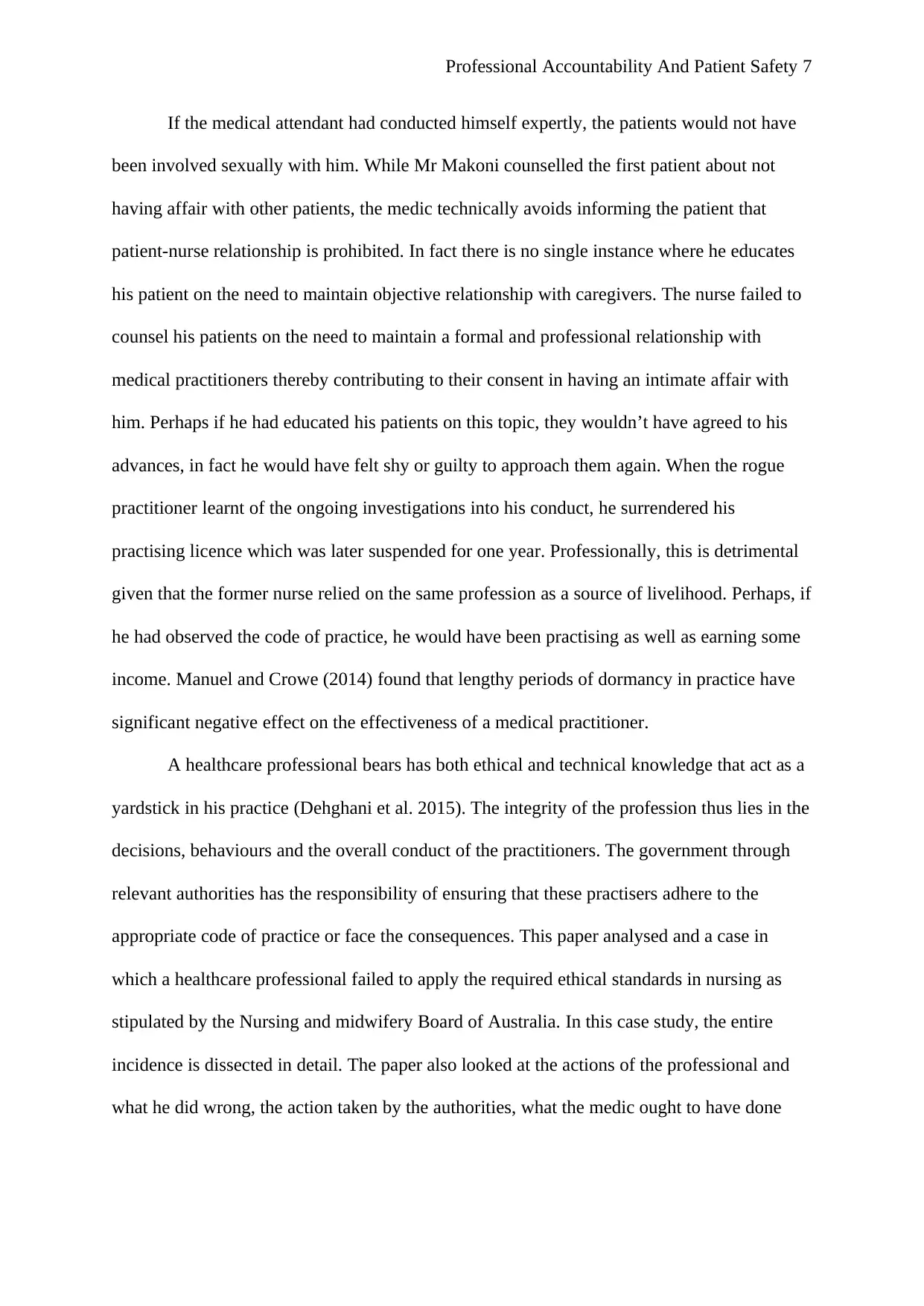
Professional Accountability And Patient Safety 7
If the medical attendant had conducted himself expertly, the patients would not have
been involved sexually with him. While Mr Makoni counselled the first patient about not
having affair with other patients, the medic technically avoids informing the patient that
patient-nurse relationship is prohibited. In fact there is no single instance where he educates
his patient on the need to maintain objective relationship with caregivers. The nurse failed to
counsel his patients on the need to maintain a formal and professional relationship with
medical practitioners thereby contributing to their consent in having an intimate affair with
him. Perhaps if he had educated his patients on this topic, they wouldn’t have agreed to his
advances, in fact he would have felt shy or guilty to approach them again. When the rogue
practitioner learnt of the ongoing investigations into his conduct, he surrendered his
practising licence which was later suspended for one year. Professionally, this is detrimental
given that the former nurse relied on the same profession as a source of livelihood. Perhaps, if
he had observed the code of practice, he would have been practising as well as earning some
income. Manuel and Crowe (2014) found that lengthy periods of dormancy in practice have
significant negative effect on the effectiveness of a medical practitioner.
A healthcare professional bears has both ethical and technical knowledge that act as a
yardstick in his practice (Dehghani et al. 2015). The integrity of the profession thus lies in the
decisions, behaviours and the overall conduct of the practitioners. The government through
relevant authorities has the responsibility of ensuring that these practisers adhere to the
appropriate code of practice or face the consequences. This paper analysed and a case in
which a healthcare professional failed to apply the required ethical standards in nursing as
stipulated by the Nursing and midwifery Board of Australia. In this case study, the entire
incidence is dissected in detail. The paper also looked at the actions of the professional and
what he did wrong, the action taken by the authorities, what the medic ought to have done
If the medical attendant had conducted himself expertly, the patients would not have
been involved sexually with him. While Mr Makoni counselled the first patient about not
having affair with other patients, the medic technically avoids informing the patient that
patient-nurse relationship is prohibited. In fact there is no single instance where he educates
his patient on the need to maintain objective relationship with caregivers. The nurse failed to
counsel his patients on the need to maintain a formal and professional relationship with
medical practitioners thereby contributing to their consent in having an intimate affair with
him. Perhaps if he had educated his patients on this topic, they wouldn’t have agreed to his
advances, in fact he would have felt shy or guilty to approach them again. When the rogue
practitioner learnt of the ongoing investigations into his conduct, he surrendered his
practising licence which was later suspended for one year. Professionally, this is detrimental
given that the former nurse relied on the same profession as a source of livelihood. Perhaps, if
he had observed the code of practice, he would have been practising as well as earning some
income. Manuel and Crowe (2014) found that lengthy periods of dormancy in practice have
significant negative effect on the effectiveness of a medical practitioner.
A healthcare professional bears has both ethical and technical knowledge that act as a
yardstick in his practice (Dehghani et al. 2015). The integrity of the profession thus lies in the
decisions, behaviours and the overall conduct of the practitioners. The government through
relevant authorities has the responsibility of ensuring that these practisers adhere to the
appropriate code of practice or face the consequences. This paper analysed and a case in
which a healthcare professional failed to apply the required ethical standards in nursing as
stipulated by the Nursing and midwifery Board of Australia. In this case study, the entire
incidence is dissected in detail. The paper also looked at the actions of the professional and
what he did wrong, the action taken by the authorities, what the medic ought to have done
Paraphrase This Document
Need a fresh take? Get an instant paraphrase of this document with our AI Paraphraser
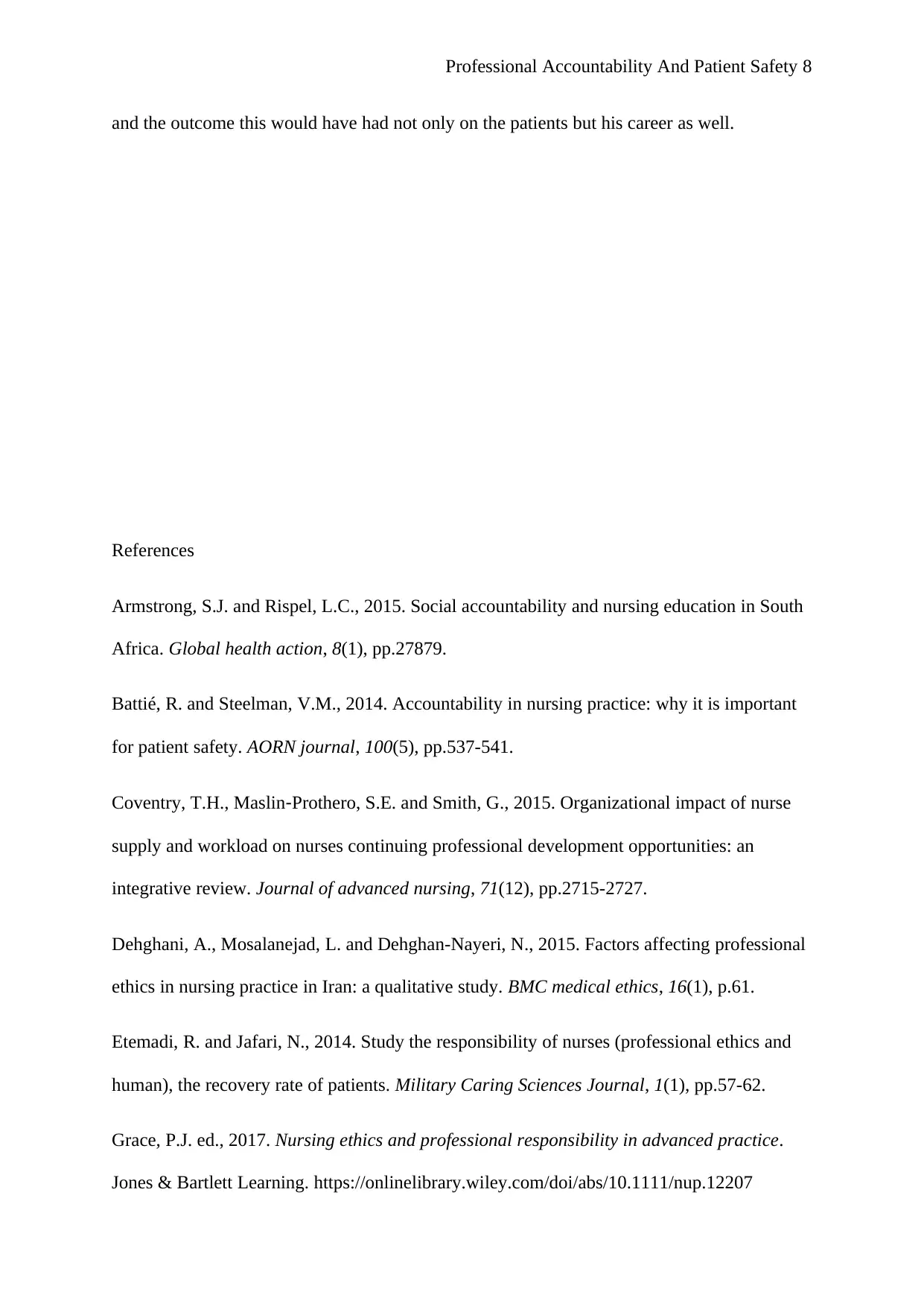
Professional Accountability And Patient Safety 8
and the outcome this would have had not only on the patients but his career as well.
References
Armstrong, S.J. and Rispel, L.C., 2015. Social accountability and nursing education in South
Africa. Global health action, 8(1), pp.27879.
Battié, R. and Steelman, V.M., 2014. Accountability in nursing practice: why it is important
for patient safety. AORN journal, 100(5), pp.537-541.
Coventry, T.H., Maslin‐Prothero, S.E. and Smith, G., 2015. Organizational impact of nurse
supply and workload on nurses continuing professional development opportunities: an
integrative review. Journal of advanced nursing, 71(12), pp.2715-2727.
Dehghani, A., Mosalanejad, L. and Dehghan-Nayeri, N., 2015. Factors affecting professional
ethics in nursing practice in Iran: a qualitative study. BMC medical ethics, 16(1), p.61.
Etemadi, R. and Jafari, N., 2014. Study the responsibility of nurses (professional ethics and
human), the recovery rate of patients. Military Caring Sciences Journal, 1(1), pp.57-62.
Grace, P.J. ed., 2017. Nursing ethics and professional responsibility in advanced practice.
Jones & Bartlett Learning. https://onlinelibrary.wiley.com/doi/abs/10.1111/nup.12207
and the outcome this would have had not only on the patients but his career as well.
References
Armstrong, S.J. and Rispel, L.C., 2015. Social accountability and nursing education in South
Africa. Global health action, 8(1), pp.27879.
Battié, R. and Steelman, V.M., 2014. Accountability in nursing practice: why it is important
for patient safety. AORN journal, 100(5), pp.537-541.
Coventry, T.H., Maslin‐Prothero, S.E. and Smith, G., 2015. Organizational impact of nurse
supply and workload on nurses continuing professional development opportunities: an
integrative review. Journal of advanced nursing, 71(12), pp.2715-2727.
Dehghani, A., Mosalanejad, L. and Dehghan-Nayeri, N., 2015. Factors affecting professional
ethics in nursing practice in Iran: a qualitative study. BMC medical ethics, 16(1), p.61.
Etemadi, R. and Jafari, N., 2014. Study the responsibility of nurses (professional ethics and
human), the recovery rate of patients. Military Caring Sciences Journal, 1(1), pp.57-62.
Grace, P.J. ed., 2017. Nursing ethics and professional responsibility in advanced practice.
Jones & Bartlett Learning. https://onlinelibrary.wiley.com/doi/abs/10.1111/nup.12207
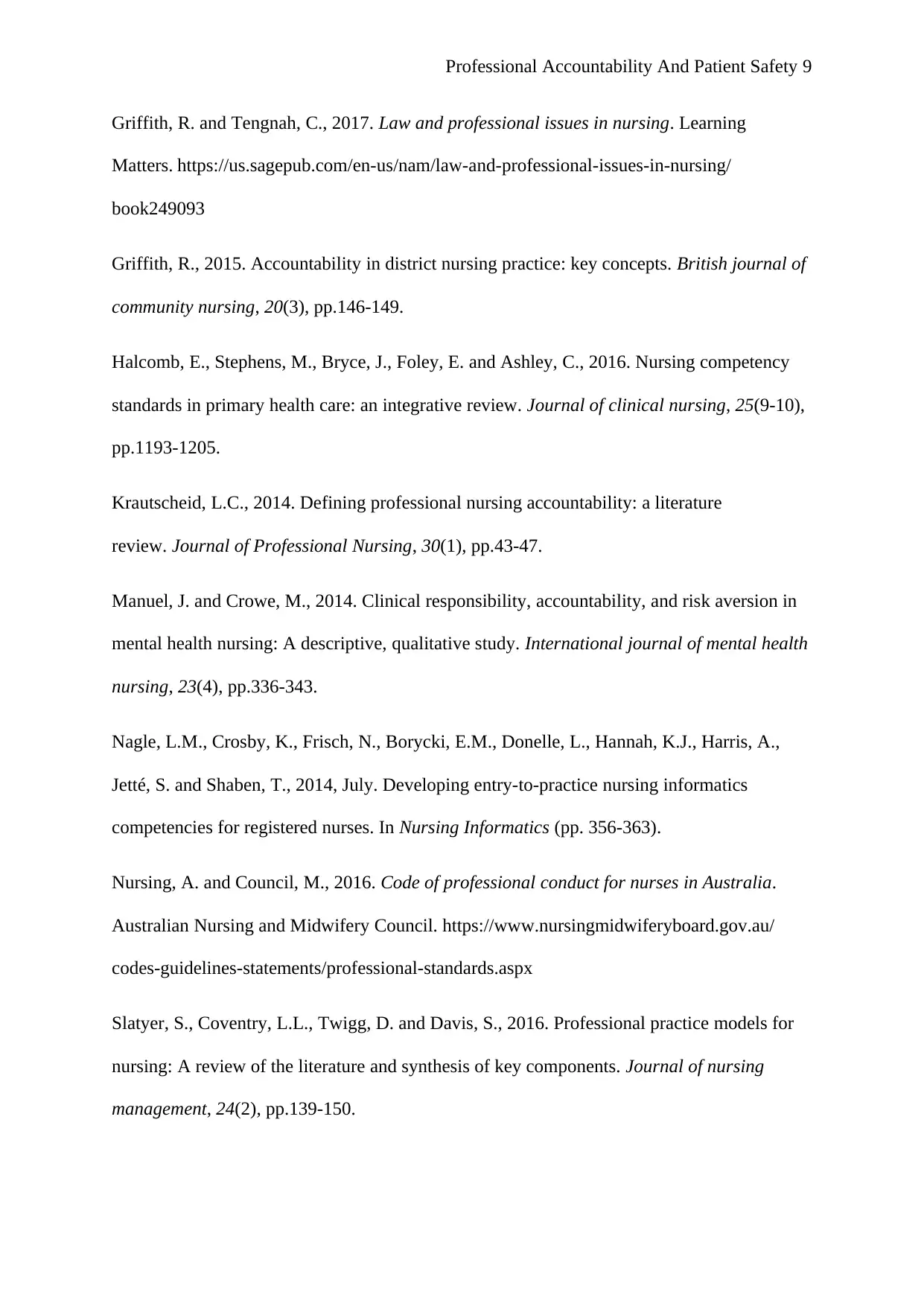
Professional Accountability And Patient Safety 9
Griffith, R. and Tengnah, C., 2017. Law and professional issues in nursing. Learning
Matters. https://us.sagepub.com/en-us/nam/law-and-professional-issues-in-nursing/
book249093
Griffith, R., 2015. Accountability in district nursing practice: key concepts. British journal of
community nursing, 20(3), pp.146-149.
Halcomb, E., Stephens, M., Bryce, J., Foley, E. and Ashley, C., 2016. Nursing competency
standards in primary health care: an integrative review. Journal of clinical nursing, 25(9-10),
pp.1193-1205.
Krautscheid, L.C., 2014. Defining professional nursing accountability: a literature
review. Journal of Professional Nursing, 30(1), pp.43-47.
Manuel, J. and Crowe, M., 2014. Clinical responsibility, accountability, and risk aversion in
mental health nursing: A descriptive, qualitative study. International journal of mental health
nursing, 23(4), pp.336-343.
Nagle, L.M., Crosby, K., Frisch, N., Borycki, E.M., Donelle, L., Hannah, K.J., Harris, A.,
Jetté, S. and Shaben, T., 2014, July. Developing entry-to-practice nursing informatics
competencies for registered nurses. In Nursing Informatics (pp. 356-363).
Nursing, A. and Council, M., 2016. Code of professional conduct for nurses in Australia.
Australian Nursing and Midwifery Council. https://www.nursingmidwiferyboard.gov.au/
codes-guidelines-statements/professional-standards.aspx
Slatyer, S., Coventry, L.L., Twigg, D. and Davis, S., 2016. Professional practice models for
nursing: A review of the literature and synthesis of key components. Journal of nursing
management, 24(2), pp.139-150.
Griffith, R. and Tengnah, C., 2017. Law and professional issues in nursing. Learning
Matters. https://us.sagepub.com/en-us/nam/law-and-professional-issues-in-nursing/
book249093
Griffith, R., 2015. Accountability in district nursing practice: key concepts. British journal of
community nursing, 20(3), pp.146-149.
Halcomb, E., Stephens, M., Bryce, J., Foley, E. and Ashley, C., 2016. Nursing competency
standards in primary health care: an integrative review. Journal of clinical nursing, 25(9-10),
pp.1193-1205.
Krautscheid, L.C., 2014. Defining professional nursing accountability: a literature
review. Journal of Professional Nursing, 30(1), pp.43-47.
Manuel, J. and Crowe, M., 2014. Clinical responsibility, accountability, and risk aversion in
mental health nursing: A descriptive, qualitative study. International journal of mental health
nursing, 23(4), pp.336-343.
Nagle, L.M., Crosby, K., Frisch, N., Borycki, E.M., Donelle, L., Hannah, K.J., Harris, A.,
Jetté, S. and Shaben, T., 2014, July. Developing entry-to-practice nursing informatics
competencies for registered nurses. In Nursing Informatics (pp. 356-363).
Nursing, A. and Council, M., 2016. Code of professional conduct for nurses in Australia.
Australian Nursing and Midwifery Council. https://www.nursingmidwiferyboard.gov.au/
codes-guidelines-statements/professional-standards.aspx
Slatyer, S., Coventry, L.L., Twigg, D. and Davis, S., 2016. Professional practice models for
nursing: A review of the literature and synthesis of key components. Journal of nursing
management, 24(2), pp.139-150.
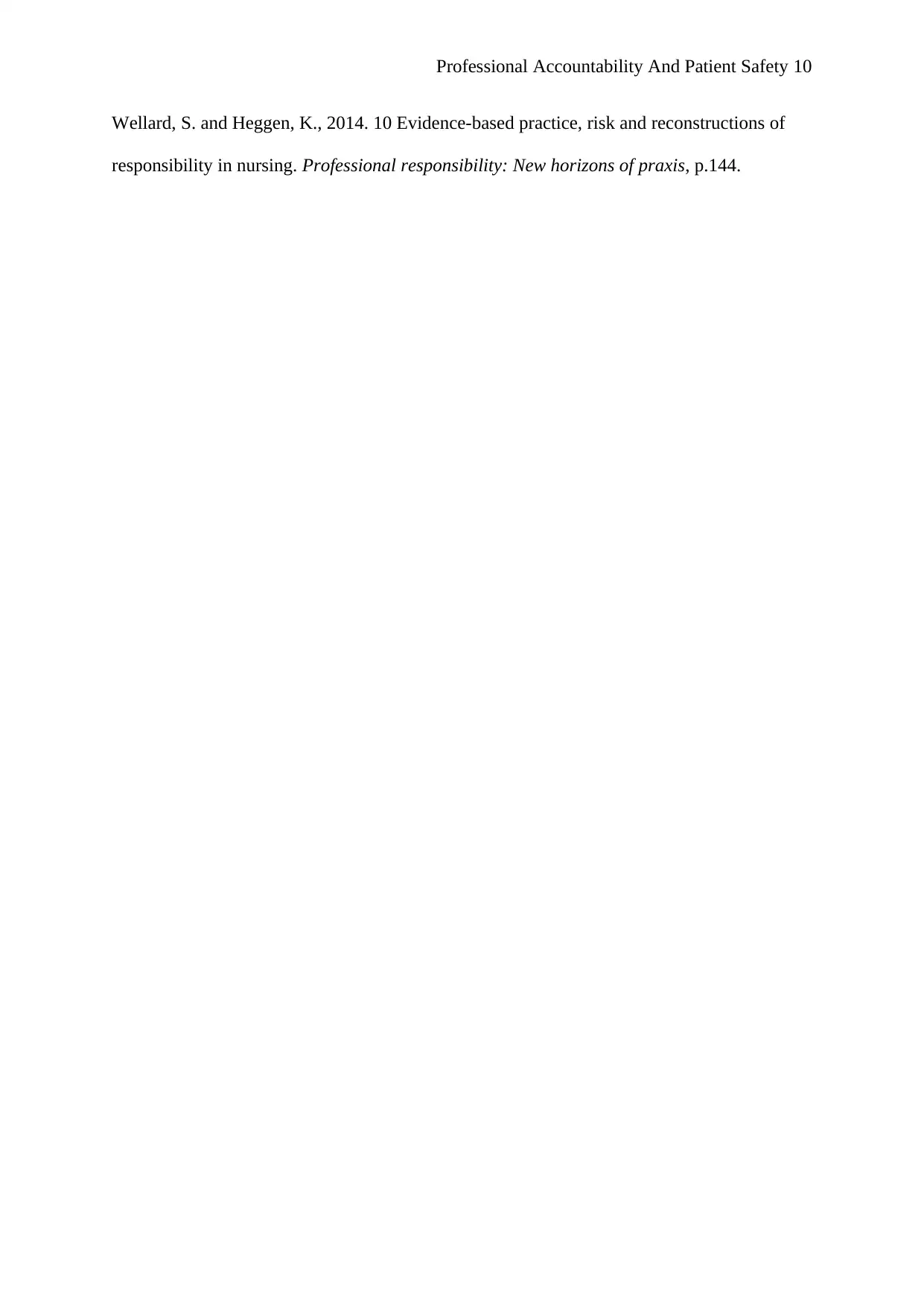
Professional Accountability And Patient Safety 10
Wellard, S. and Heggen, K., 2014. 10 Evidence-based practice, risk and reconstructions of
responsibility in nursing. Professional responsibility: New horizons of praxis, p.144.
Wellard, S. and Heggen, K., 2014. 10 Evidence-based practice, risk and reconstructions of
responsibility in nursing. Professional responsibility: New horizons of praxis, p.144.
1 out of 10
Related Documents
Your All-in-One AI-Powered Toolkit for Academic Success.
+13062052269
info@desklib.com
Available 24*7 on WhatsApp / Email
![[object Object]](/_next/static/media/star-bottom.7253800d.svg)
Unlock your academic potential
© 2024 | Zucol Services PVT LTD | All rights reserved.





